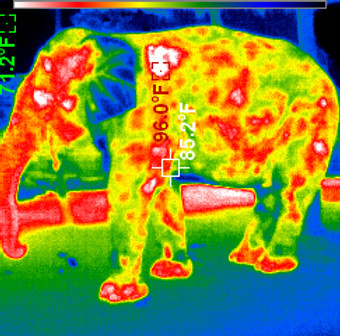
Exploring New and Affordable Technologies for Elephant Care
Our team at ECI has a special interest in identifying ways to improve diagnosis and treatment for both common and hard-to diagnose conditions of elephants. While western zoos can often afford to buy expensive equipment, that is not an option at most elephant care facilities in Asia. Our goal is to find cost-effective methods that can benefit the most number of veterinarians and the elephants they care for. Here are some of our ongoing projects.
Diagnosing Heart Problems
The sheer size of elephants make diagnosing internal problems difficult. Elephants are simply too large for x-rays to penetrate the chest or abdomen. Heart problems are particularly challenging as we can’t even hear the heart in most adult elephants using a regular stethoscope. So this very basic means to assess cardiac function has been largely unavailable to elephant veterinarians.
Electronic Stethoscope / EKG. We were excited when we saw this stethoscope at a recent conference. We have done some preliminary work with elephants in Myanmar and it is promising. We have to find the exact position but we can hear the heart! And it looks like we can get a good EKG tracing too. We will be exploring this further in the coming months. Many thanks to Ele-Vet for providing the stethoscope at a discounted price. See photo.
Measuring Blood Pressure. This is another common test that we are all familiar with. Very little has been published about measuring blood pressure in elephants. In one unpublished study that looked at blood pressure in elephants in Nepal, the author found that overall the elephants in Nepal had lowered blood pressure than zoo elephants in the U.S.
We want to know if we can get reliable blood pressure readings in elephants using an inexpensive human blood pressure unit. Based on our preliminary work movement has been an issue but in the near future we will be testing elephants that have received positive reinforcement training (PRT) to hold their tails still. See photo.
Treating Pain
The "Loop". Dr. Mikota became aware of the “The Loop” while listening to an online presentation on non-pharmaceutical options for pain relief in small animals and horses. The loop transmits targeted pulsed electromagnetic field therapy (tPEMF) which helps reduce pain and swelling and speed up the body's natural recovery process. Treatments are usually given for 15 minutes twice day.
While it may sound like magic, this therapy has been used to treat non-union bone fractures for many years. And this is an FDA-approved method of treatment. Only recently though have home care devices become available for humans and animals.
The complicated diagram seen to the right explains the science behind tPEMF. Basically, tPEMF activates nitrous oxide which increases blood flow, counters inflammation, speeds healing, and reduces pain. We are still exploring whether PEMF can help elephants as it has helped people and other animals.
Identifying Problem Areas
Thermography. Simply identifying the location of a problem in an elephant can be challenging. Thermography may help. Thermography detects different surface temperatures. It can detect areas of inflammation and can be used to monitor response to treatment.
The elephant seen at right (below) has a chronic shoulder wound incurred when she was shot in the wild. The thermal image seen below shows an elevated temperature and inflammation at the wound site (in white).
Some thermographic cameras cost over $10,000. But Flir makes a much more affordable unit (under $400 on Amazon). Although not intended for medical purposes, it may be useful for the types of problems we see in elephants in Asia.
Please consider a donation to help us explore new, emerging technologies for helping elephants. DONATE HERE!





(Above) From Strauch et al. 2009. (Below): Dr. Susan Mikota tests "The Loop" at Green Hill Valley in Myanmar.




